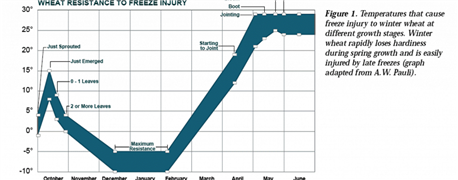
A hard red winter wheat market analyst has sharply increased his estimate of the amount of damage that resulted from the hard freeze on March 19 and 20 and now says that winter wheat harvest will be down by as much as 50 million bushels in Texas, Oklahoma and Kansas.
Initial reports of freeze damage put harvest losses at about 15.5 million bushels, but fell far short of the probable hit because the analysts tended to put the maturity of the crop far behind its actual development, says Wayne T. Parman with Grain of Truth, a Chicago trading company.
In revising his estimates of losses sharply upward, Parman said that jointing of the winter wheat crop was much higher than he initially estimated.

For example, in projecting Kansas losses at 7.7 million bushels initially, Parman was estimating 10% jointing in the South Central district and 4% in the central area with 5% in the southwest.
However, in reality, the south central district was actually at 41%, the central was 14% and the southwest was 5%. Parman now projects Kansas losses at 30 million bushels, half of those in the highest yielding part of the state south of Wichita.
Parman initially estimated winter wheat yield losses at 3.75 million bushels with jointing estimated at about 10% statewide.
Real crop progress shows Oklahoma actual jointing was 38%. The new estimated losses are about 12 million bushels.
Texas losses were initially estimated at 3 to 5 million bushels assuming a jointing average of about 5 to 10%. The winter wheat crop was actually about 22% jointed, raising the loss estimate to 8 to 10 million bushels.
Parman emphasized that the estimate losses are just that -- estimates.
"We will not know until final harvest data next fall what yields were in these areas and yields in other parts of the states could offset some of these assumed losses," Parman said.
About the Author(s)
You May Also Like






